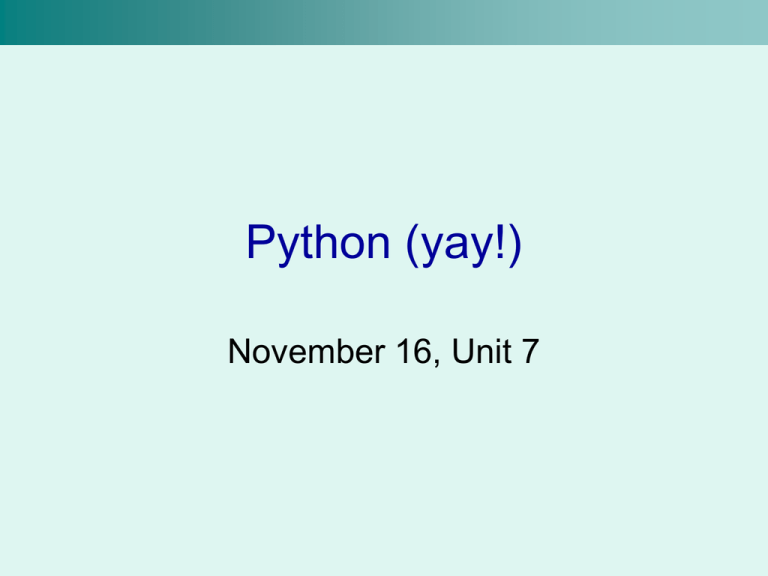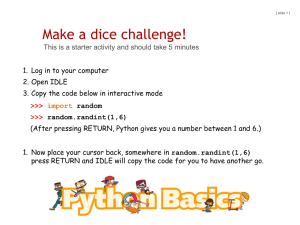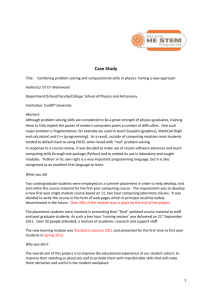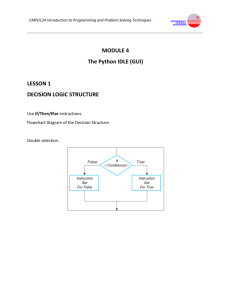ppt
advertisement

Python (yay!) November 16, Unit 7 Recap • We can store values in variables using an assignment statement >>>x = 4 + 8 • We can get input from the user using raw_input() >>>name = raw_input(“Enter your name”) • We can change the data from one type to another >>>num = int(raw_input(“Enter a number”)) Conditional Statements • So far the programs we’ve written are pretty boring • Like with XSL we can use conditional statements to do more • Basically conditional statements check to see if something is true. – If it is true, some code is executed – Perhaps if its not true, different code is executed • Simplest conditional statement is the “if” statement The If Statement • The if statement in Python works just like the if statement in XSL – The syntax is different – Concept is the same • If the number is less than 5, print “that number is less than 5” • If the name is “C.S.Lewis”, print “this book is by C.S.Lewis” If Statement, cont. num = int(raw_input(“Enter a number less than 10”)) if num>10: print “That number is bigger than 10. You can’t follow directions” print “Thanks for playing!” If, cont. • The syntax for the if statement is as follows: if expression: code • The code you want executed if the expression is true must be indented – This is the body of your if statement • Spacing is important in python – You should indent consistently – Convention is to indent 4 spaces (use the tab) • When you stop indenting, the body of the if statement is considered to be done – The code after the indention will execute no matter what In-Class Example • Using if statements Boolean Expressions • When we use an if statement, the result of the expression is either true or false – if 4<3: (false) – if 3<4: (true) • The result of the expression must be true or false • Otherwise it doesn’t make sense • These are called boolean expressions • The two boolean values are “true” and “false” Boolean Values, cont. • Boolean values in python (like most languages) are stored as integers • 0 represents false – 4<3 as an expression has the value 0 • Any other integer (usually 1) represents true – 3<4 has the value of 1 • You can actually write code like: if 1: …… if 5: ……. Boolean Expressions • We’re pretty used to seeing <, <=, >, >= in conditional statements – They make sense and read just like regular English • What if we want to check if something is equal to something else? – if 4-3 = 1: • This is an assignment statement • Does not check to see if 4 minus 3 equals 1 • We need to use the == operator – if 4-3 ==1: • If we want to check if two items are not equal use the != operator - if 4-2!=1: Else Clause • In XSL we can use <xsl:choose>, <xsl:when>, and <xsl:otherwise> – This provides us with a sort of if, else if, else if….else structure • Python has something similar • We can use the else clause to provide a sort of “if not” If 3<4 then print “woohoo” else print “darn. I don’t know math” • Code inside the else clause will be executed only if the expression in the if statement evaluates to false If Else Example guess = int(raw_input(“Pick a number between 1 and 10”)) if guess<=10: print “Good job!” else: print “Can’t you follow directions!?” In-Class Example • Example using if/else • Example using strings elif block: Else if • The if/else structure is pretty useful • There is one more component to this structure: the “else if” block • Basically we can now write code that reads something like: – if, else if, else if, …..,else • To use an else if structure we need the word “elif” – elif requires an expression (just like if) Elif Example if guess== number: print “you guessed it!” elif guess< number: print “that’s too low” else: print “that’s too big!” In-Class Example with elif • Changing the number guessing game to use elif • Inventory with elif We Can Nest “if” Statements • We can nest if statements inside other if statements – Or inside elif statements – Or inside else statements – Basically anywhere • Remember that nested ifs are only executed if the outer ifs are evaluated as true In-Class nested If example • Checking to be sure the number is within range Random Number • So far we have had to pre-select a number for the user to guess – num = 7 – It’s the same every time – Pretty boring once you guess the number • It would be better if every time we ran the program it chose a random number for us to guess • In order to use random numbers it requires two parts: – Importing the random module – Using a function from the random module to generate our random number Random Numbers, cont. import random num = random.randint(1,10) • Import tells python to include the random module – There are lots of modules – More on this later • random.randint(1,10) – In the random module, use the randint function to select a random number between 1 and 10 – This is assigned to the variable num • random.randint(5, 50) – Select a random integer between 5 and 50 In-Class Example • Adding a random number to our guessing game Libraries • It would stink if every time we needed a random number we had to write the code to produce one • Or how about something like calculating the sin of a number • Or the square root • With most programming languages some functions are included with the language – These are usually grouped into libraries – We only have to import the libraries or modules we need – If we imported every module it would take a long time to run • In python, all of the prepackaged functions are considered to be part of the python library – The individual parts we will import will be modules or libraries • Terms are pretty much interchangeable – Slightly different terminology from other languages Modules • When we needed the random number we had to import the random module • The random module contains a function called randint() which is what actually gives us the random number • The syntax for importing a module is: import moduleName • We only import the modules we need Accessing Functions in Modules • To use a function found in a module we have to use the following syntax: moduleName.functionName(…) • There are a lot of modules – There is a link to the reference on the course page • Some of the common ones are random, math, and cmath • We’ll be covering many more modules In-Class Example • Import the string module • Use it to uppercase an entire string Questions? • What you should get from this lecture: – If statements – else clause – elif clause – Nesting if statements – How to produce a random integer – How to access functions in modules







